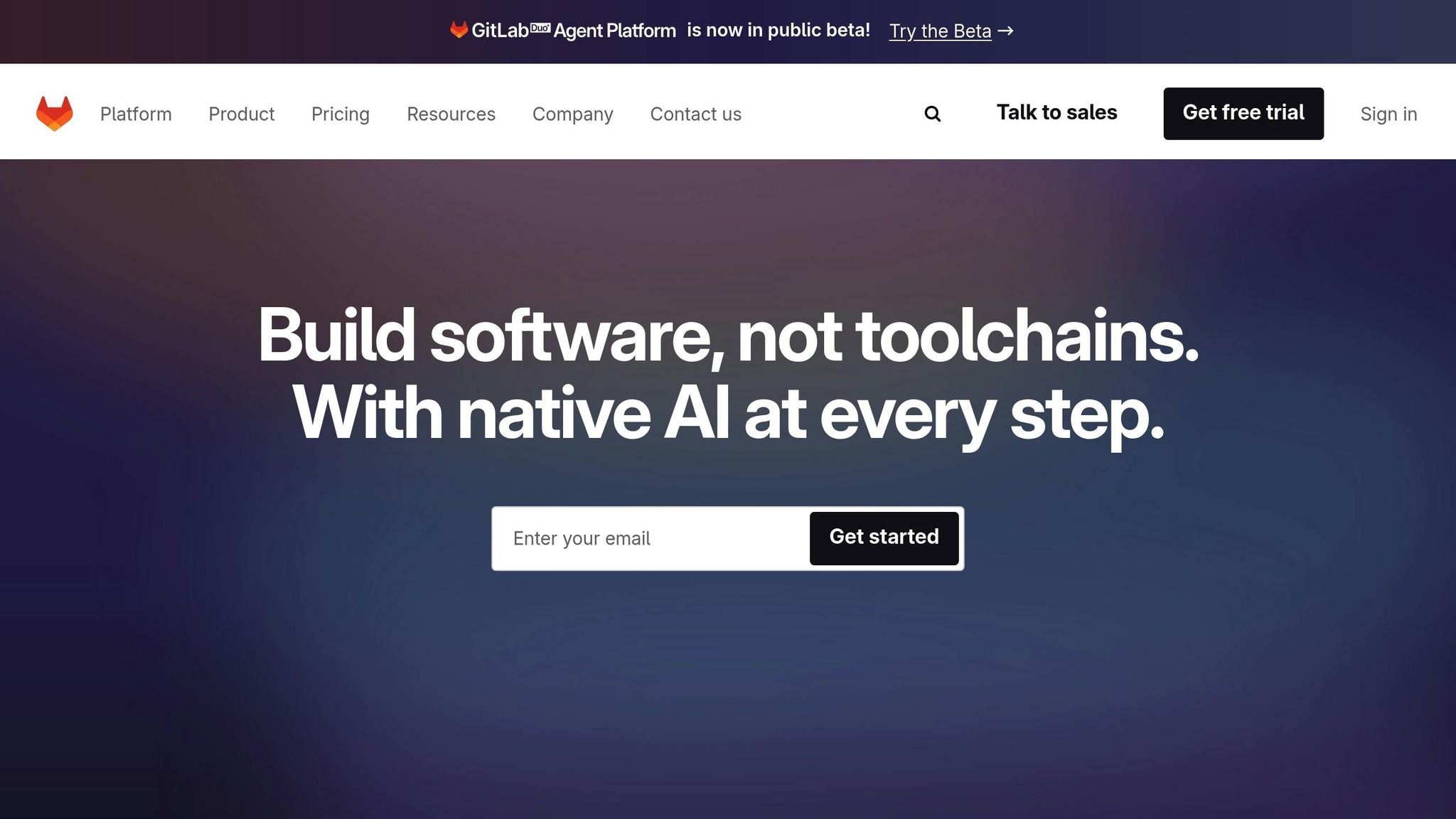Dependency Scanning in DevOps Pipelines

Dependency scanning is a critical part of DevOps security, automatically identifying vulnerabilities in third-party libraries and packages used in software development. By analyzing dependency manifests like package.json or requirements.txt, these tools match components against vulnerability databases such as the NVD and CVE. This ensures that both direct and nested (transitive) dependencies are checked for risks.
Here’s why it matters:
- Modern apps rely heavily on third-party dependencies, increasing exposure to security risks like supply chain attacks.
- Automated scanning integrates into CI/CD pipelines, detecting issues early in development and preventing insecure code from reaching production.
- It saves time and money by addressing vulnerabilities before they escalate into costly breaches or compliance failures.
Key steps include dependency discovery, vulnerability matching, and generating actionable reports that prioritize fixes based on severity. Tools like GitHub Advanced Security, Snyk, and Trivy make this process efficient by embedding scanning directly into workflows.
Takeaway: Integrating dependency scanning into DevOps pipelines reduces risk, supports faster deployments, and strengthens application security.
How to use dependency scanning tutorial hands-on GitLab Application Security part 3

How Dependency Scanning Works
Grasping how dependency scanning operates is key to weaving it effectively into DevOps workflows. At its core, the process involves several interconnected steps aimed at detecting and reporting vulnerabilities within your application’s dependencies. Below, we break down the steps, explore how to integrate scanning into your pipelines, and explain how to manage and share results effectively.
Main Steps in Dependency Scanning
The first step in dependency scanning is dependency discovery, where the scanner identifies all the components your application relies on. This involves parsing manifest files specific to your programming language and package manager. For example:
- JavaScript projects use package.json
- Python projects rely on requirements.txt or Pipfile
- Java projects reference pom.xml or build.gradle
Once the dependencies are identified, the scanner constructs a dependency tree. This map includes both direct and transitive dependencies, exposing even those hidden layers of dependencies that might not be immediately obvious.
Next comes vulnerability matching, where dependencies are checked against known vulnerability databases. The National Vulnerability Database (NVD) is a primary resource, offering detailed information on security flaws. Supplementary data comes from sources like GitHub Security Advisories and language-specific repositories.
During this phase, the scanner analyzes each dependency’s name, version, and configuration. It looks for exact matches and broader version ranges that might be impacted by vulnerabilities. It also assesses the severity of each issue using the Common Vulnerability Scoring System (CVSS), which rates vulnerabilities on a scale from 0.0 to 10.0. To help address these issues, the scanner provides actionable fixes, such as upgrading to patched versions.
Finally, the scanner compiles all findings into concise reports. These reports outline vulnerability details, affected components, severity ratings, and recommendations for remediation, giving teams a clear path forward.
Adding Scanning to DevOps Pipelines
Incorporating dependency scanning into your DevOps pipeline ensures vulnerabilities are caught early without slowing down deployment.
- Pre-commit scanning happens before code is even pushed. Developers run scans locally, catching issues immediately. While effective, this relies on developer discipline and can slow workflows if not optimized.
- Build-time scanning occurs during the CI/CD pipeline, after dependencies are installed but before application testing. This strikes a balance between early detection and automation. For instance, a Jenkins pipeline might include a scanning stage right after the build phase. Here, the pipeline downloads dependencies, runs the scanner, and archives reports. If critical vulnerabilities are found, the pipeline can fail the build, preventing insecure code from advancing.
- Deployment gates act as a final checkpoint before production. These gates enforce stricter policies, focusing on addressing high and critical vulnerabilities that pose immediate risks.
TECHVZERO offers seamless integration of dependency scanning into CI/CD workflows, ensuring robust security checks without disrupting deployment speed. Their approach optimizes scan performance while maintaining thorough coverage, allowing teams to ship code quickly and securely.
Collecting and Sharing Results
Turning raw scan data into actionable insights is crucial for prioritizing and addressing vulnerabilities effectively. This involves centralizing reports, analyzing risks, and ensuring findings are shared with the right people.
- Centralized reporting brings scan results from various sources and stages into one unified dashboard. These dashboards give teams a clear overview of vulnerabilities, track trends over time, and highlight urgent issues.
- Risk prioritization helps teams focus on critical vulnerabilities first. Beyond CVSS scores, this process considers factors like real-world exploitability, patch availability, and the business impact of affected components.
- Automated notifications ensure that relevant team members are alerted promptly. For instance, critical issues might trigger immediate alerts to security teams, while less severe ones could be grouped into periodic reports.
- Integration with development workflows simplifies remediation. Findings can be linked directly to tools developers already use, such as creating tickets in project management systems, generating pull requests with fixes, or updating documentation with recommendations.
Effective implementations also include progress tracking, which monitors remediation efforts and measures improvements over time. This data helps organizations understand their security posture and allocate resources wisely.
TECHVZERO’s result management systems integrate seamlessly with existing development workflows. By ensuring findings reach the right people at the right time, they help teams resolve vulnerabilities faster and reduce overall security risks efficiently.
Tools and Methods for Dependency Scanning
Dependency scanning uses specialized tools to identify vulnerabilities in software dependencies. Choosing the right tool depends on your specific security requirements. Below, we’ll explore some widely-used tools and compare their features to help you make an informed decision.
Popular Dependency Scanning Tools
- GitHub Advanced Security: This tool integrates seamlessly with GitHub repositories, alerting developers to vulnerabilities via pull requests and security advisories. Its tight integration with the GitHub workflow makes it a practical choice for teams already using the platform.
- Snyk: Known for its developer-first approach and support for multiple programming languages, Snyk not only scans dependencies but also container images and infrastructure as code. It provides actionable remediation advice and offers both CLI and web-based interfaces, making it easy to include in various workflows.
- Trivy: A lightweight, open-source tool designed to scan containers, file systems, and Git repositories. Trivy’s speed and efficiency make it a great fit for CI/CD pipelines where quick scans are critical.
- OWASP Dependency-Check: Maintained by the OWASP community, this tool focuses on identifying vulnerabilities in project dependencies. It supports report generation in multiple formats, making it a reliable choice for many teams.
- npm audit: Built specifically for Node.js projects, this tool scans dependency manifest files during package management. Its zero-configuration setup provides instant feedback on vulnerabilities, making it ideal for Node.js developers.
For added security, language-specific scanners like Safety for Python and Bundler-audit for Ruby offer targeted solutions tailored to specific ecosystems.
Tool Comparison
Here’s a quick comparison of the key aspects of these tools:
| Tool | Integration | Licensing | Comments |
|---|---|---|---|
| GitHub Advanced Security | Native GitHub workflow | Paid | Best for teams using GitHub |
| Snyk | CI/CD friendly | Free/Paid | Provides clear remediation advice |
| Trivy | Lightweight CLI | Open source | Great for container-focused pipelines |
| OWASP Dependency-Check | Plugin ecosystem | Open source | Reliable for detecting known issues |
| npm audit | Built into npm | Free | Streamlined for Node.js projects |
Optimizing Your Scanning Strategy
TECHVZERO takes a comprehensive approach by integrating multiple scanners to enhance both security and developer experience. For example, language-specific tools provide immediate feedback during development, while broader platforms ensure enterprise-level visibility. This combination helps teams identify vulnerabilities early without slowing down deployment cycles.
When selecting a scanner, it’s crucial to balance factors like coverage, ease of integration, and cost. Many teams find success by using a mix of tools to address both immediate needs and long-term security goals.
sbb-itb-f9e5962
Best Practices for Dependency Scanning
Getting dependency scanning right means ensuring security without slowing down development. To achieve this, it’s essential to implement smart strategies, like integrating security gates and leveraging automation tools, to keep your pipeline both secure and efficient.
Setting Up Security Gates and Rules
Security gates serve as automated checkpoints in your CI/CD pipeline, stopping code with vulnerabilities from moving forward. The key is finding the right balance between protecting your system and maintaining development speed.
Start by defining clear thresholds for vulnerabilities based on their severity. For instance, many organizations block code containing critical or high-severity vulnerabilities while allowing medium and low-severity issues to pass if properly documented. For example, your pipeline could fail any build that includes critical vulnerabilities or more than five high-severity issues.
Timing is everything when it comes to security gates. A good practice is to run quick scans during the commit phase to catch obvious issues early, followed by a more thorough scan before merging code into the main branch.
Consider introducing grace periods – typically 48 to 72 hours – for addressing newly discovered vulnerabilities before they block builds. Also, establish a clear process for handling exceptions, such as requiring documented approval from security teams and setting automatic expiration dates for temporary bypasses.
Automated Alerts and Team Communication
Manually tracking vulnerabilities just doesn’t work at modern development speeds. Automated alerts ensure that security issues are flagged and sent to the right people immediately. However, poorly configured alerts can overwhelm teams and lead to alert fatigue.
To avoid this, use smart routing to prioritize notifications. For example, critical vulnerabilities could trigger instant Slack messages to security teams and on-call developers, while medium-severity issues might be summarized in a daily email to project maintainers.
Integrating alerts with existing communication tools makes them more actionable. When a scan detects an issue, automated messages can include direct links to the affected code, suggested fixes, and an estimate of the effort needed to resolve the problem.
Alert consolidation is another way to prevent overload. Group related issues by project, severity, or component, and provide teams with weekly summary reports to track progress and identify patterns. Don’t forget to celebrate wins – automated recognition for fixing vulnerabilities or hitting security goals can boost morale and encourage good practices.
Using TECHVZERO‘s Services

TECHVZERO’s tools make these best practices easier to implement by automating key scanning and remediation tasks. Their solutions reduce the manual effort that often slows down security processes.
With TECHVZERO, dependency scanning becomes more efficient through automated updates, optimized resource management, and scalable solutions. For example, their expertise in cloud cost reduction ensures that comprehensive scans don’t lead to inflated infrastructure expenses. They achieve this by right-sizing scanning resources, fine-tuning scan schedules, and using efficient result caching.
For teams bogged down by manual tasks, TECHVZERO offers automation services to handle repetitive work. This includes automatic dependency updates for low-risk patches, smarter prioritization of vulnerabilities based on actual code usage, and self-healing systems that can apply security fixes automatically when it’s safe to do so.
Their platform also scales effortlessly as your organization grows. Adding new projects, programming languages, or deployment targets doesn’t require manual reconfiguration – TECHVZERO’s solutions adapt to your evolving needs, making them a reliable partner for long-term security planning.
The Future of Dependency Scanning in DevOps
Dependency scanning has become a cornerstone of modern DevOps practices. With development cycles moving faster than ever and security threats growing more advanced, automated tools for spotting vulnerabilities are no longer optional – they’re essential. Let’s dig into how this technology is evolving and the benefits it brings to the table.
Key Points
Integrating dependency scanning into CI/CD pipelines offers far more than just meeting security checkboxes. By catching vulnerabilities early in the development process, teams can save significant time and money compared to fixing issues after they’ve made it to production. Scanning at the commit level allows for quicker, more precise fixes tailored to the context of the code.
Automation is the backbone of scaling dependency scanning. Modern tools are designed to handle massive libraries of dependencies at lightning speed, delivering results without slowing down developers. Features like intelligent alerting and automated fixes help teams maintain high security standards without sacrificing productivity.
For organizations, comprehensive dependency scanning isn’t just about reducing vulnerabilities – it’s about minimizing the fallout from potential security breaches. Fewer incidents mean lower costs, less downtime, and a stronger reputation. Plus, these tools make it easier to stay ahead of compliance rules, avoiding penalties and audit headaches.
But the story doesn’t end here. Emerging trends are poised to push dependency scanning to the next level.
Future Trends and Changes
The future of dependency scanning is being shaped by artificial intelligence (AI) and machine learning (ML). These technologies are making automation even smarter, improving accuracy while reducing the need for manual oversight. AI-driven systems are becoming adept at spotting zero-day vulnerabilities and understanding which issues pose the greatest risks to specific applications. By analyzing how code interacts with networks and potential attack paths, these tools provide more targeted risk assessments.
Another exciting development is contextual scanning. Instead of flagging every vulnerability, regardless of its relevance, future tools aim to evaluate how dependencies are actually used in an application. This means fewer false alarms and a sharper focus on the vulnerabilities that matter most.
Dependency scanning is also becoming tightly integrated with cloud environments and orchestration platforms. This holistic approach ensures consistent security policies across everything from local development setups to live production environments.
Collaboration tools are evolving too, making it easier for security and development teams to work hand-in-hand. Features like shared dashboards, automated task assignments, and workflow triggers tailored to team expertise are helping resolve issues faster while fostering better communication and knowledge sharing.
As software ecosystems grow more intricate, scanning tools are adapting with supply chain analysis features. These capabilities trace the origins of code components, offering a clear view of where vulnerabilities come from and how they might ripple through other systems. This level of insight is crucial for managing today’s complex dependency landscapes.
FAQs
How can dependency scanning be seamlessly integrated into DevOps workflows without affecting development speed?
Dependency scanning fits effortlessly into DevOps workflows by automating vulnerability detection in dependencies right within the CI/CD pipeline. The latest tools are designed to work quietly in the background with minimal setup, keeping your development process secure without causing interruptions.
By moving security checks left – integrating them earlier in the development cycle – teams can catch and resolve issues as they arise, minimizing risks while keeping deployments on schedule. Automated tools take care of regular scans and updates, removing the need for manual effort and ensuring the pipeline stays fast and dependable.
How can AI and machine learning improve dependency scanning tools in DevOps pipelines?
AI and machine learning are transforming dependency scanning tools by taking over the tedious task of spotting outdated or vulnerable libraries. Instead of relying heavily on manual checks, these technologies automate the process, offering real-time alerts to keep teams informed. They also use predictive analytics to flag potential risks early, giving teams a head start on addressing issues before they escalate.
With the ability to process massive datasets, AI-powered tools deliver quicker and more precise vulnerability assessments. This proactive approach helps teams manage risks effectively while bolstering overall security. Plus, it simplifies DevOps workflows, paving the way for smoother and more dependable deployments.
How can organizations prioritize vulnerabilities from dependency scanning to improve remediation efforts?
When organizations conduct dependency scanning, prioritizing vulnerabilities becomes essential. One effective way to do this is by using standardized scoring systems like the Common Vulnerability Scoring System (CVSS). These scores help gauge the level of risk each vulnerability presents, factoring in both its potential impact and how easily it could be exploited.
The focus should be on tackling critical and high-severity vulnerabilities first, especially those that threaten essential systems. To ensure prioritization is accurate, it’s important to regularly match vulnerability data with a current inventory of IT assets. Automating this process and integrating threat intelligence can make the workflow smoother, enabling teams to allocate resources wisely and address the most urgent risks without delay.